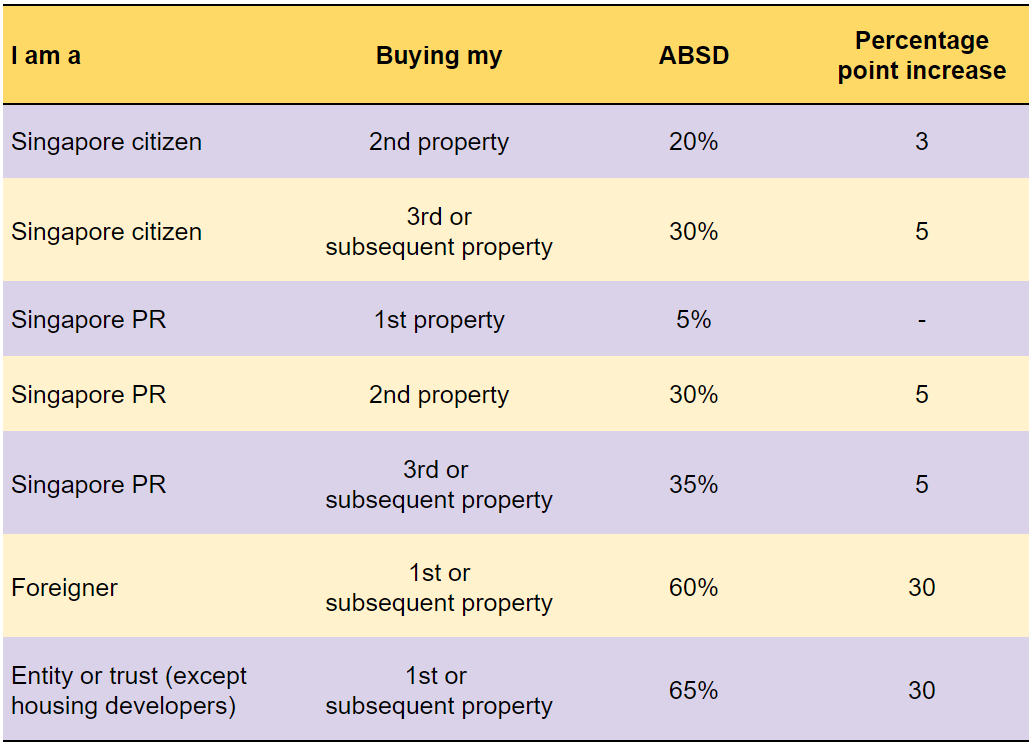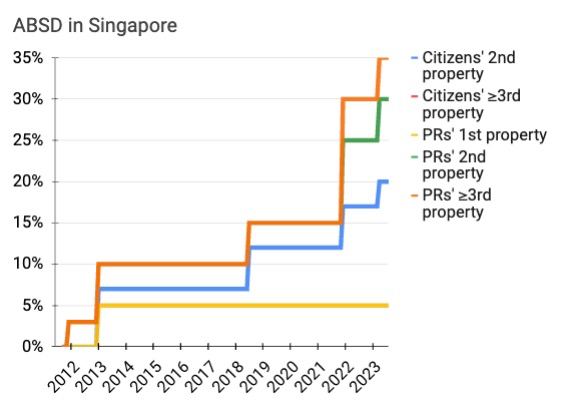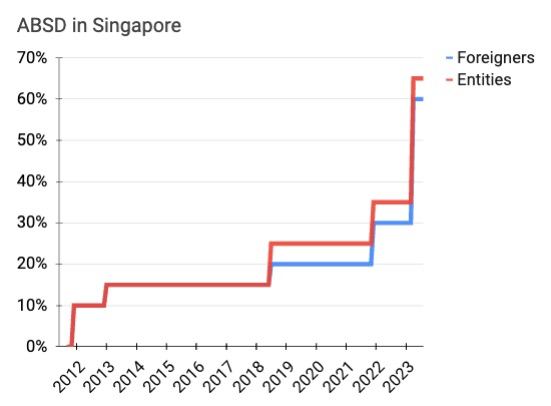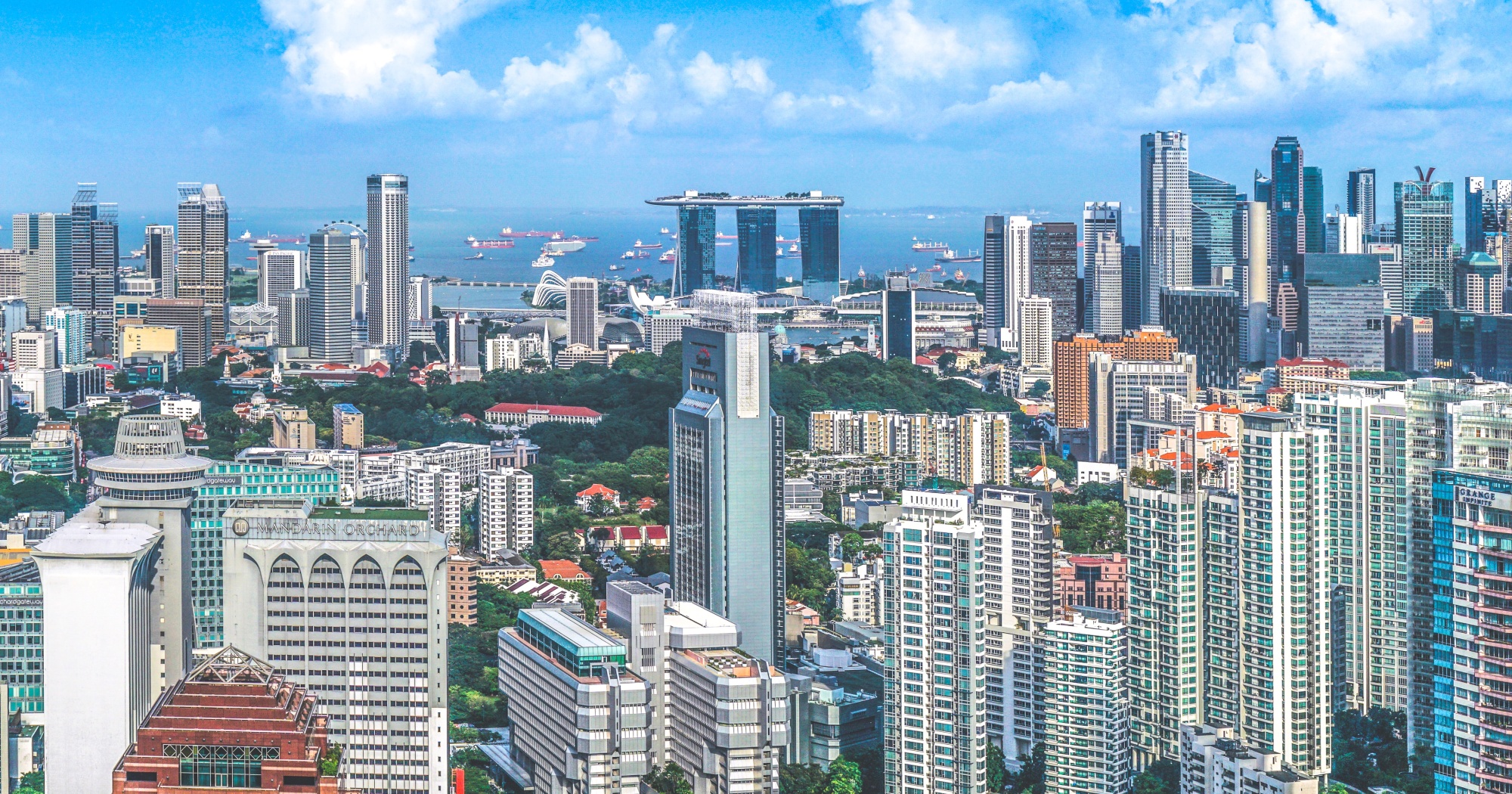From Apr. 27, the Additional Buyers Stamp Duty (ABSD) will go up by between 3 and 30 percentage points, depending on several factors, such as your residency status and the number of properties you already possess.
What's the Additional Buyers Stamp Duty (ABSD)?
When you buy a piece of residential property in Singapore, you need to pay a tax on the documents relating to the transaction.
This is called the Buyers Stamp Duty.
Singaporean permanent residents and foreigners have to pay another tax, the Additional Buyers Stamp Duty, on top of that.
Singapore citizens only need to pay the Additional Buyers Stamp Duty on their second piece of residential property onwards.
How much is the Additional Buyers Stamp Duty? It is computed as a percentage of the property value or its selling price, whichever is higher.
This are the new Additional Buyers Stamp Duty rates, effective from Apr. 27:

Who is going to be affected the most by the higher ABSD?
Both locals and foreigners will be affected by the higher ABSD, though some more than others.
Looking at the way the increase in ABSD has been tiered, foreign buyers will take the biggest hit since they face the highest amount of increase: double the previous ABSD amount.
Using the example of a S$1.5 million condominium unit, a foreigner would now have to fork out S$900,000 for the ABSD. Last December, they would only have had to pay S$450,000 for the ABSD. That's an increase of S$450,000
Singapore citizens and permanent residents looking to buy their second and subsequent properties will also see some impact, though not as much as foreigners.
Using the same condominum unit example, the ABSD amount for a Singapore citizen buyer will increase by at least S$45,000, while the amount for a Singapore PR buyer will increase by S$75,000.
Speaking to the media on Apr. 27, Minister for National Development Desmond Lee said the increase is smaller for Singaporean citizens because they are "very price-sensitive to ABSD moves". This means that a 3 to 5 per cent increase "should suffice to dampen local investment demand".
Sellers of residential property will also see some impact. Their pool of interested buyers would likely shrink as a result of the new rates, and sellers may have to accept lower resale prices.
The expected increase in public and private housing supply that is underway also means that there may be more housing options for buyers, which might also drive down resale prices.
Who's going to benefit the most from the higher ABSD?
On the other hand, Singapore citizens or permanent residents buying their first residential property will benefit the most since the increase in Additional Buyers Stamp Duty does not apply to them.
This group of people make up the majority of buyers of residential property (about 90 per cent), based on 2022 data, said the Ministry of National Development, the Monetary Authority of Singapore, and the Ministry of Finance in a joint statement on Apr. 26.
Singapore citizens do not have to pay an Additional Buyers Stamp Duty when they purchase their first residential property.
Singapore permanent residents currently have to pay a 5 per cent Additional Buyers Stamp Duty on their first residential property. This has remained unchanged.
Making it harder to purchase additional properties means that those who are first-time buyers -- typically those who are looking to buy a house to live in -- will benefit the most.
The government also affirmed that the latest measure will prioritise housing for owner-occupation (as opposed to property investment).
Why do we have the Additional Buyers Stamp Duty?
The Additional Buyers Stamp Duty was introduced in December 2011 to reduce the high demand for residential property in Singapore, which in turn, was driving up property prices.
Housing is, first and foremost, for people to live in.
But in Singapore, people can also buy property for investment purposes -- like when you buy a private condominium unit (or a whole-ass bungalow) to rent it out, or sell off your BTO flat (which you bought from the government at a subsidised price) on the open market for a "windfall".
When there is excessive demand for housing for investment purposes, it can price out those who are looking to buy property to live in and make the property cycle volatile.
When the Additional Buyers Stamp Duty was introduced in December 2011, the Monetary Authority of Singapore (MAS) said a volatile property cycle would "increase the risks to our economy and banking system".
 Increases in ABSD over the years for citizens and PRs. Graph by Nigel Chua.
Increases in ABSD over the years for citizens and PRs. Graph by Nigel Chua.
 Increases in ABSD over the years for foreigners and entities. Graph by Nigel Chua.
Increases in ABSD over the years for foreigners and entities. Graph by Nigel Chua.
The Additional Buyers Stamp Duty was introduced to curb rising investment demand -- especially from foreign buyers who were charged the highest ABSD rate of 10 per cent -- ensuring that the property market was "stable and sustainable" and prioritising home-occupation before investment.
Just one tool in a whole toolbox to manage demand for local property
The Additional Buyers Stamp Duty is just one tool that the Singapore government uses to manage demand for residential property.
The last hike before 2023 occurred in December 2021.
Back then, it was increased to 17 per cent for citizens buying their second residential property, and 25 per cent for those buying their third and subsequent properties.
Other tools for managing property demand (commonly referred to as "cooling measures") include making it harder for buyers to qualify for housing loans, increasing the minimum amount of cash downpayment required when purchasing property, and extending the minimum occupation period before a buyer is able to sell their property.
Most recently, cooling measures were implemented in December 2021 and September 2022 and they have had a "moderating effect".
However, demand for local property is surging again, which leads us to the latest ABSD hike.
According to the government, this is to "pre-emptively manage investment demand".
There is strong demand from locals looking to purchase property to live in.
At the same time, there has also been renewed interest from local and foreign investors in Singapore's residential property market.
"If left unchecked, prices could run ahead of economic fundamentals, with the risk of a sustained increase in prices relative to incomes."
The government also pointed out that it is currently increasing the supply of housing units -- both private and public.
There were about 40,000 public and private residential property completions in 2023. The government is also expecting close to 100,000 units to be completed from 2023 to 2025.
The increase in housing supply will work in tandem with the higher ABSD to moderate housing demand and ensure that those looking to buy property to live in will be prioritised.
Top image by Mike Enerio on Unsplash
If you like what you read, follow us on Facebook, Instagram, Twitter and Telegram to get the latest updates.
